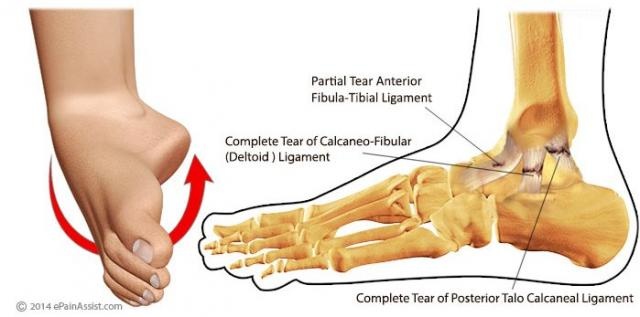Ankle sprain
Text in part from “Running Doc’s Guide”, by Dr. Lewis G. Maharam, MD.
The ankle is what I call “the great pretender” of the body, capable of ballooning threateningly after a minor sprain (tearing of ligaments – they attach bone to bone) or concealing a serious fracture behind nothing more than an unpleasant throb.
(from Running Doc’s Guide to Healthy Running) As a sport medicine physician, I’ve called them wrong both ways, finding just minor soft tissue damage after X-rays of patients I was ready to put into a cast and finding unexpected bone chips in others who were still managing daily workouts. It’s chancy to assume, as so many of us do, that just because what’s happening now feels like what happened last time, it is what happened last time.
 Fortunately, fractures are far less common than sprains. And if a fracture is caught early, a couple of weeks in a cast usually permits rapid healing. Procrastinate, and the bone chip may migrate to someplace you don’t want it and will have to come out with surgery if you expect to finally be rid of the pain. Then we’re into real convalescence. So the rule is, know the difference. If there is any swelling after an ankle injury, please have it X-rayed. But first things first.
Fortunately, fractures are far less common than sprains. And if a fracture is caught early, a couple of weeks in a cast usually permits rapid healing. Procrastinate, and the bone chip may migrate to someplace you don’t want it and will have to come out with surgery if you expect to finally be rid of the pain. Then we’re into real convalescence. So the rule is, know the difference. If there is any swelling after an ankle injury, please have it X-rayed. But first things first.
The instant you’re hurt, ask yourself, “Can I keep going?” If you can still run with the same stride, then go ahead. But if you start compensating, or if your biomechanics change even slightly, stop.
Three grades (from American Academy of orthopaedic Surgeons)
The amount of force determines the grade of the sprain. A mild sprain is a Grade 1. A moderate sprain is a Grade 2. A severe sprain is a Grade 3.
- Grade 1 sprain (mild sprain) : slight stretching and some damage to the fibers (fibrils) of the ligament.
- Grade 2 sprain (moderate sprain) : partial tearing of the ligament. If the ankle joint is examined and moved in certain ways, abnormal looseness (laxity) of the ankle joint occurs.
- Grade 3 sprain (severe sprain) : complete tear of the ligament. If the examiner pulls or pushes on the ankle joint in certain movements, gross instability occurs.
When it’s a grade 1 and most of grade 2 sprains, there is lot more you can do than the usual RICE (rest, ice, compression, elevation). Ice is indispensable of course, 2 or 3 times a day for 15 minutes. And then instead of RICE, try MICE, substituting motion for rest. Sit cross-legged and pretend there is a pencil extending from you big toe. Now pretend to trace – with your foot, not just your toe – the capital letters of the alphabet from A to Z six times a day. This moves the ankle in every direction, bringing blood flow and more rapid healing. With the initial injury, this will be painful and the letters small. As you progress, the letters will get bigger and bigger.
The faster you get your ankle moving, the faster you will be back on the road, pain-free. You may as soon as you can do so without changing your form. Running also brings in more blood flow for rapid healing.
Run safely!



